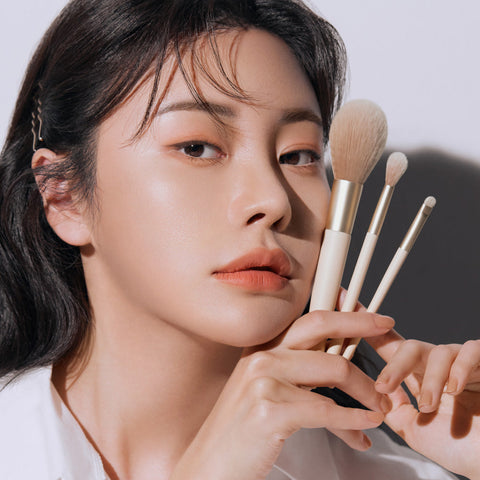During the menstrual cycle, hormonal changes occur in the body that affect many physiological functions – including the skin. Many women notice their skin changing during different phases of the cycle: sometimes it is radiant and even, while at other times it becomes oily and prone to breakouts. Can skincare be adapted according to the menstrual cycle? In this article, we will explore how you can tailor your skincare routine to your cycle and whether it is a necessary method for you!

Phases of the menstrual cycle and their effects on the skin 💫
There are different phases during the cycle, which can be roughly divided into two: the follicular phase and the luteal phase. The follicular phase begins with menstruation and the luteal phase begins when ovulation starts. Therefore, these two phases can also be divided into four: menstruation, follicular, ovulation, luteal.
It wouldn't be ideal to change up your routine several times over the course of one month, but with small changes, you can take into account your skin's varying needs. So you don't need a completely different skincare routine for each different phase!
Next, let's go through the different phases of the menstrual cycle together and how they affect your skin. At the same time, we will provide tips on which ingredients to favor and what practical advice you can use to incorporate these ingredients into your routine.

Follicular phase (days 1–13, from menstruation to the start of ovulation)
Phase 1, menstruation: During this phase, estrogen levels are relatively low. Low estrogen, progesterone, and testosterone levels can make the skin feel drier than usual.
Favor: Moisturizing and strengthening ingredients such as hyaluronic acid, collagen, PHA and ceramides. Moisturizing sheet masks can support skin's well-being and also provide well-deserved pampering at this stage ❤️
Star products:
- SKIN1004 Centella Probio-Cica Essence Toner
- Numbuzin no. 6 Deep Sleep Mask Serum
- Isntree Yam Root Vegan Milk Cream
- Mediheal Hydra Soothing Mask

Phase 2, after menstruation: After menstruation, estrogen levels rise more significantly and the skin's moisture balance improves. For some, this can be the best phase for skin condition, but if your skin is prone to impurities, it may be wise to prepare with products that control oil production.
Favor: Moisturizing and balancing ingredients such as niacinamide, ectoin, centella, and PHA as well as antioxidants, such as vitamin C, to support the skin's protective mechanisms.
Star products:

Luteal phase (days 14–28)
Phase 3, ovulation: at the time of ovulation (around day 14), estrogen reaches its peak, but progesterone levels also rise, which can increase sebum production. This may lead to increased skin brightness in some, while in others, the skin may start to break out, so the skin may require more balancing products and gentle exfoliation.
Favor: Balancing and soothing ingredients, such as niacinamide, green tea and tea tree. Since the skin may become oilier at this stage, you might need less moisturizer than usual. Oily skin can also benefit from ingredients that support skins renewal such as retinol and reedle products, which help the skin stay better balanced and help control breakouts. BHA and AHA, aka chemical exfoliants, also help to fight pimples and blackheads.
Star products:
- Some By Mi Bye Bye Blackhead 30 Days Miracle Green Tea Tox Bubble Cleanser
- VT Cosmetics Cica Reti-A Essence 0.1
- Kaine Green Calm Aqua Cream

Step 4, after ovulation, before menstruation: The skin may be at its most sensitive at this stage and more prone to various inflammations. Avoid harsh and strong products and favor skin-soothing and gently exfoliating ingredients. As menstruation begins, the skin's moisture balance decreases again, so it is not advisable to attack skincare too aggressively, but be gentle
Suosi: basic moisturizing and inflammation-soothing ingredients, such as centella, PDRN, ectoine, and panthenol
Star products:
- VT Cosmetics PDRN Essence 100
- Numbuzin no. 6 Deep Sleep Mask Serum
- 'hwarang' Bellflower Moisturizing Barrier Cream
![[hwarang'] Bellflower Moisturizing Barrier Cream](https://cdn.shopify.com/s/files/1/0550/1927/4448/files/hwarang-barrier-cream-mood4.webp?v=1734307018)
Should skincare be adjusted according to the menstrual cycle?
It's very individual! If you feel that your skin's needs change significantly during the month, and you don't always understand your skin's quirks, it might be good to take that into account. On the other hand, if your skin's needs remain relatively stable, it may not be as beneficial for you. Ultimately, it's simply about being mindful and considering its needs 🙏🏼 While adapting the cycle to skincare can help better understand the skin's needs, the most important thing is to find the right products and routine for yourself 💜
________________________________________________________________
Sources:
Farage, Miranda A. PhD*; Neill, Sallie MD†; MacLean, Allan B. MD‡. Physiological Changes Associated with the Menstrual Cycle: A Review. Obstetrical & Gynecological Survey 64(1):p 58-72, January 2009. | https://doi.org/10.1097/OGX.0b013e3181932a37
- R. S. Raghunath, Z. C. Venables, G. W. M. Millington, The menstrual cycle and the skin, Clinical and Experimental Dermatology, Volume 40, Issue 2, 1 March 2015, Pages 111–115, https://doi.org/10.1111/ced.12588
- Wong, Michelle (Dr). The Science of Beauty. 2024. DK London. Penguin Random House. p 66-67.



 info@yeppo.fi
info@yeppo.fi
 14 vrk palautusoikeus
14 vrk palautusoikeus
 PCI-DSS Compliant
PCI-DSS Compliant
 PayPal Buyer Protection
PayPal Buyer Protection
 Klarna – Pay Securely
Klarna – Pay Securely